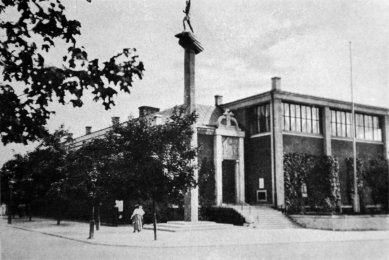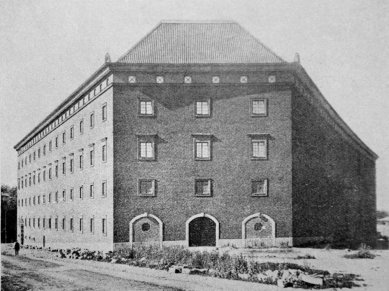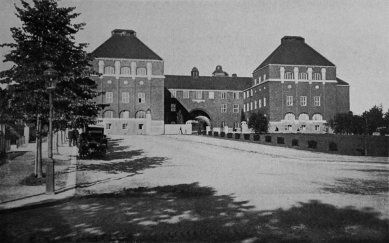
Alois Kubíček: The Swedish Way
The Gothenburg Jubilee Exhibition, organized to commemorate the three-hundredth anniversary of the city's founding, was the impetus for the chief municipal engineer A. Lilienberg to initiate the organization of an international city planning exhibition as part of the general exhibition. It was therefore very appropriate to hold a congress at this time titled "International Federation for the Establishment of Garden Cities and Urban Planning." The congress was also attended by 9 delegates from our republic (Ministry of Public Works, Masaryk Academy of Labor, cities of Prague and Brno).
Our delegates, as they participated in the discussions of the congress and the entire excursion program, gained two powerful impressions that would be difficult to summarize for an outsider. The first impression is that the only guiding idea in today's urban planning is the decentralization of cities. Therefore, the idea confirmed and invigorated by the testimonies of delegates from around the world today forms a rule for every city regardless of the regions of the country, the nature of the terrain, etc. The second unforgettable impression is that Sweden is that fortunate country that accepts new teachings unreservedly, just as cities in Europe once embraced the French model of urban planning, and it realizes them in a range of examples that serve as valid models for us. Furthermore, Sweden is a country experiencing a period of artistic consolidation, which has already produced many examples evidencing a significant contemporary expansion of domestic art.
The exhibition itself already confirmed this impression. Architects A. Bjezhem and S. Ericson, who collaborated with the well-known sculptor C. Milles, managed to resolve the construction and solutions for both provisional and permanent exhibition buildings and all the decor that accompanies the exhibition not only successfully but also exemplary. The exhibition site itself is adjacent to the new part of the city and is its natural continuation. There is no forced difference as is often found between the exhibition quarter surrounding and the exhibition itself. There is only one spirit evident that created both, and there is no purely exhibitionist illusion that, as is often the case in other exhibitions, often acts exotically. The city of Gothenburg itself is a classic example of how a sudden shift can be made in urban construction, definitively summing up the bewildered practices of the 1880s and 90s, which are just as discouraging in Gothenburg as in Prague or anywhere else. Gothenburg shares with Prague the commonality that the practices of the 1880s and 90s did not account for the challenging terrain there or here, creating places without character and thus also without significance. However, it is now possible to study in Gothenburg what we need to know for the building development of cities with a similar foundation (Prague, Brno, Bratislava). Even in the issue of solving the post-war housing question, Gothenburg is at an enviable height. It is aware that as the second-largest city in the country (with 228,000 inhabitants) it must now act purposefully. Large apartment buildings are designated only for larger apartments. Small apartments are provided in small houses with a maximum of two stories. Today, the city is surrounded by several independent garden suburbs, of which the Landala colony makes the most architecturally effective impression. The garden suburbs already occupy an area of over 423,000 m². Most of the houses are wooden and built on land under hereditary lease for 70 years.
If Gothenburg still awaits the significant task of constructing new monumental buildings (technology, square in front of the exhibition), Stockholm has already accomplished a large part of this task.
It seems that architect Ragnar Ostberg, today the most famous architect in Sweden, has created in the new city hall of Stockholm a work that will still be considered one of the greatest contemporary artistic expressions for a long time. Not knowing his work, strictly utilitarian, like the residence of the British ambassador, would lead one to assume that he delights in a romantic foundation and that those reminiscences of outstanding buildings from all possible countries and times, which he harmonized in the monumental expression of the new city hall, were not merely a means for creating a great monumental building that must also convey poetic appeal. The situational resolution, the escalation of the building into a mass dominating a broad area of the city, is the only example in the construction of the town hall.
Another modern monumental building is the technical university, an exemplary situation of how a complex of buildings of various needs can be perfectly mastered. Architect E. Lallerstedt, the creator of this school, is also a distinctive follower of modern Swedish architecture, which no longer lives from the teachings of foreign schools. Among the constructions now completed, the work of architect Cyrilla Johansson, the "house of the alcohol monopoly," is notable. On the other hand, the attempt by architect S. Wallander to create the first skyscraper is a work of no significance. Notable is Stockholm's communal housing policy. The city has been trying to acquire land adjacent to the city since 1904 and is now the owner of 4,521 ha. Through land ownership, it determines the development of the city according to its wishes and plans. This method has only a correspondence in one of our cities, Hradec Králové. The property of the Prague municipality is still not having a favorable influence.
The prudent housing policy of the city of Stockholm has led to the establishment of large garden cities around the city, including Enskede in 1908, Äpppelviken in 1911, and Smedslätt in 1922. Before construction began on the designated lands, a network of tramways and roads was pre-built, sewer systems established, electric lighting and gas introduced, and a water supply - that is, the obvious things. The official report on these municipal projects states that initially, the public had little interest in garden cities, as for several generations they had been tied to the city center. The idea of an independent home also seemed to many to be economically unfeasible. However, due to the energetic work of the city, interest has arisen so that today there is still insufficient response to the demand for land in garden cities. The city established a special financial institution aimed at providing loans for construction in garden cities. The land is also only leased under a hereditary contract for 60 years. This method has not yet been established in Sweden but is proving to be effective. In garden cities, over 10,000 residents currently live, of which there are 210 m² of land per person, whereas within Stockholm, there are only 35 m² of land. At a banquet held in honor of the congress in the golden hall of the new city hall, the representative of the municipality even mentioned that the Swedes also learned urban planning in the "golden Prague." Unfortunately, he could only speak of a beautiful past. Today, once again, the Swedes can serve as our model.
Our delegates, as they participated in the discussions of the congress and the entire excursion program, gained two powerful impressions that would be difficult to summarize for an outsider. The first impression is that the only guiding idea in today's urban planning is the decentralization of cities. Therefore, the idea confirmed and invigorated by the testimonies of delegates from around the world today forms a rule for every city regardless of the regions of the country, the nature of the terrain, etc. The second unforgettable impression is that Sweden is that fortunate country that accepts new teachings unreservedly, just as cities in Europe once embraced the French model of urban planning, and it realizes them in a range of examples that serve as valid models for us. Furthermore, Sweden is a country experiencing a period of artistic consolidation, which has already produced many examples evidencing a significant contemporary expansion of domestic art.
The exhibition itself already confirmed this impression. Architects A. Bjezhem and S. Ericson, who collaborated with the well-known sculptor C. Milles, managed to resolve the construction and solutions for both provisional and permanent exhibition buildings and all the decor that accompanies the exhibition not only successfully but also exemplary. The exhibition site itself is adjacent to the new part of the city and is its natural continuation. There is no forced difference as is often found between the exhibition quarter surrounding and the exhibition itself. There is only one spirit evident that created both, and there is no purely exhibitionist illusion that, as is often the case in other exhibitions, often acts exotically. The city of Gothenburg itself is a classic example of how a sudden shift can be made in urban construction, definitively summing up the bewildered practices of the 1880s and 90s, which are just as discouraging in Gothenburg as in Prague or anywhere else. Gothenburg shares with Prague the commonality that the practices of the 1880s and 90s did not account for the challenging terrain there or here, creating places without character and thus also without significance. However, it is now possible to study in Gothenburg what we need to know for the building development of cities with a similar foundation (Prague, Brno, Bratislava). Even in the issue of solving the post-war housing question, Gothenburg is at an enviable height. It is aware that as the second-largest city in the country (with 228,000 inhabitants) it must now act purposefully. Large apartment buildings are designated only for larger apartments. Small apartments are provided in small houses with a maximum of two stories. Today, the city is surrounded by several independent garden suburbs, of which the Landala colony makes the most architecturally effective impression. The garden suburbs already occupy an area of over 423,000 m². Most of the houses are wooden and built on land under hereditary lease for 70 years.
If Gothenburg still awaits the significant task of constructing new monumental buildings (technology, square in front of the exhibition), Stockholm has already accomplished a large part of this task.
It seems that architect Ragnar Ostberg, today the most famous architect in Sweden, has created in the new city hall of Stockholm a work that will still be considered one of the greatest contemporary artistic expressions for a long time. Not knowing his work, strictly utilitarian, like the residence of the British ambassador, would lead one to assume that he delights in a romantic foundation and that those reminiscences of outstanding buildings from all possible countries and times, which he harmonized in the monumental expression of the new city hall, were not merely a means for creating a great monumental building that must also convey poetic appeal. The situational resolution, the escalation of the building into a mass dominating a broad area of the city, is the only example in the construction of the town hall.
Another modern monumental building is the technical university, an exemplary situation of how a complex of buildings of various needs can be perfectly mastered. Architect E. Lallerstedt, the creator of this school, is also a distinctive follower of modern Swedish architecture, which no longer lives from the teachings of foreign schools. Among the constructions now completed, the work of architect Cyrilla Johansson, the "house of the alcohol monopoly," is notable. On the other hand, the attempt by architect S. Wallander to create the first skyscraper is a work of no significance. Notable is Stockholm's communal housing policy. The city has been trying to acquire land adjacent to the city since 1904 and is now the owner of 4,521 ha. Through land ownership, it determines the development of the city according to its wishes and plans. This method has only a correspondence in one of our cities, Hradec Králové. The property of the Prague municipality is still not having a favorable influence.
The prudent housing policy of the city of Stockholm has led to the establishment of large garden cities around the city, including Enskede in 1908, Äpppelviken in 1911, and Smedslätt in 1922. Before construction began on the designated lands, a network of tramways and roads was pre-built, sewer systems established, electric lighting and gas introduced, and a water supply - that is, the obvious things. The official report on these municipal projects states that initially, the public had little interest in garden cities, as for several generations they had been tied to the city center. The idea of an independent home also seemed to many to be economically unfeasible. However, due to the energetic work of the city, interest has arisen so that today there is still insufficient response to the demand for land in garden cities. The city established a special financial institution aimed at providing loans for construction in garden cities. The land is also only leased under a hereditary contract for 60 years. This method has not yet been established in Sweden but is proving to be effective. In garden cities, over 10,000 residents currently live, of which there are 210 m² of land per person, whereas within Stockholm, there are only 35 m² of land. At a banquet held in honor of the congress in the golden hall of the new city hall, the representative of the municipality even mentioned that the Swedes also learned urban planning in the "golden Prague." Unfortunately, he could only speak of a beautiful past. Today, once again, the Swedes can serve as our model.
The English translation is powered by AI tool. Switch to Czech to view the original text source.




0 comments
add comment












